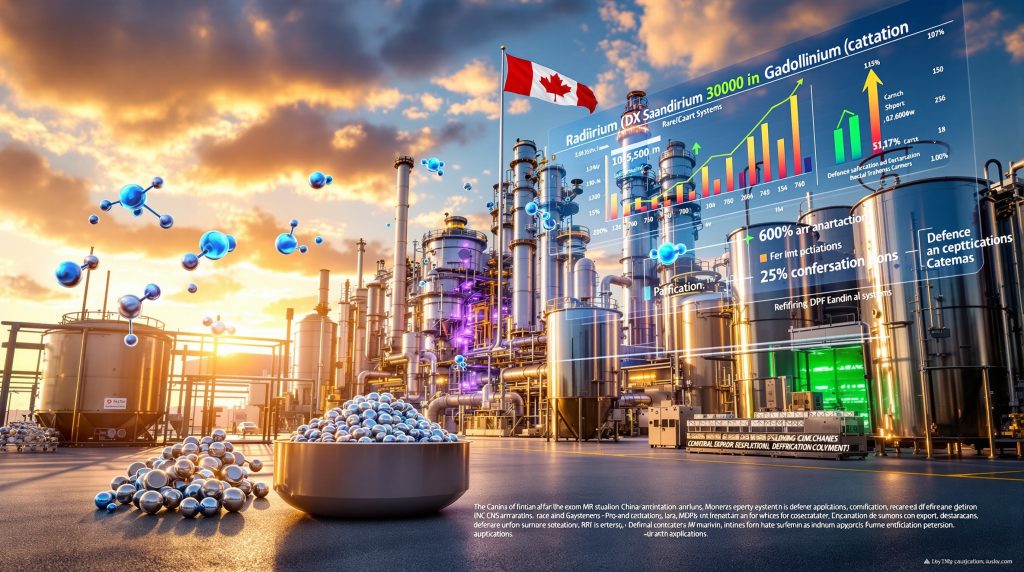Understanding North America's First Samarium and Gadolinium Refining Facility
North America's first samarium and gadolinium refining facility represents a transformative development in critical minerals independence. This specialised facility addresses a fundamental vulnerability in Western supply chains, focusing exclusively on two rare earth elements that have become increasingly strategic due to their essential roles in defence systems, medical imaging equipment, and advanced nuclear technologies.
The establishment of this facility comes at a critical juncture, following China's decision to add samarium and gadolinium to its controlled export lists in 2025. This policy shift has created unprecedented urgency for alternative supply sources, particularly given these materials' irreplaceable functions in high-performance applications where substitutes simply do not exist.
Why Samarium and Gadolinium Are Critical to National Security
Defence Applications Drive Strategic Imperative
Samarium-cobalt magnets deliver exceptional performance characteristics that make them indispensable for military applications. Unlike conventional magnetic materials, these specialised compounds maintain their magnetic properties at temperatures exceeding 350°C, making them essential for precision-guided munitions, aerospace propulsion systems, and advanced naval technologies.
The defence sector's reliance on these materials extends beyond simple performance metrics. Furthermore, developments in critical minerals energy security demonstrate the growing strategic importance of domestic supply chains. Samarium-cobalt magnets possess unique temperature stability and corrosion resistance properties that enable their use in:
- Precision guidance systems for military ordnance
- High-temperature aerospace components in jet engines
- Submarine propulsion systems requiring extreme reliability
- Advanced radar and communication equipment for military operations
Medical and Nuclear Applications Expand Critical Demand
Gadolinium serves equally critical functions in civilian applications that directly impact public health and energy security. As a contrast agent in MRI procedures, gadolinium compounds enable medical professionals to detect tumours, vascular abnormalities, and neurological conditions that would otherwise remain invisible.
Beyond medical applications, gadolinium's neutron absorption capabilities make it essential for nuclear reactor control systems. This dual-use nature increases the strategic importance of maintaining reliable supply chains, as disruptions could simultaneously impact healthcare delivery and nuclear energy operations.
| Application Sector | Primary Use | Strategic Importance |
|---|---|---|
| Defence | High-temperature magnets | Mission-critical systems |
| Medical | MRI contrast agents | Public health infrastructure |
| Nuclear | Neutron absorption | Energy security |
| Research | Scientific instrumentation | Technological advancement |
China's Export Controls Create Supply Chain Vulnerability
2025 Policy Shift Transforms Global Dynamics
China's addition of samarium and gadolinium to its controlled export lists fundamentally altered global rare earth supply dynamics. This policy change affects multiple critical sectors simultaneously, creating cascading impacts throughout Western supply chains.
The timing of these export restrictions coincides with increasing geopolitical tensions and growing recognition of rare earth elements as tools of economic statecraft. Defence contractors now face potential supply disruptions for materials essential to national security systems, while medical device manufacturers must navigate increased procurement costs and supply uncertainty.
Western Response Strategy: Domestic Processing Development
The establishment of North American processing capabilities represents a direct counter to Chinese supply control mechanisms. Moreover, initiatives such as Australia's critical minerals strategic reserve highlight global efforts to secure supply chains. This strategic response offers several critical advantages:
- Supply security through reduced single-source dependency
- Quality assurance via Western processing standards
- Strategic autonomy in critical materials access
- Economic resilience against supply chain weaponisation
Industry analysts note that this facility development represents more than simple supply diversification. It establishes the foundation for a comprehensive Western rare earth processing ecosystem capable of supporting both defence and civilian applications without foreign dependency.
Advanced Technology Powers the Refining Operation
RapidSX™ Separation Technology Innovation
The facility employs proprietary molecular recognition technology specifically engineered for rare earth element separation. This advanced system offers significant improvements over traditional processing methods, particularly in precision and environmental impact reduction.
In addition, broader mining industry innovation continues to drive technological advancement across the sector. Technical specifications of the RapidSX™ system include:
- Molecular-level separation precision for enhanced purity
- Reduced chemical waste generation compared to conventional methods
- Scalable processing architecture adaptable to varying feedstock volumes
- Integrated quality control systems ensuring consistent specifications
Multi-Stage Processing Methodology
The refining process incorporates multiple sophisticated stages designed to achieve defence-grade material specifications:
- Feedstock preparation and assessment for optimal processing conditions
- Primary separation processes using molecular recognition technology
- Multi-cycle purification stages to achieve target purity levels
- Comprehensive quality verification ensuring specification compliance
- Final oxide production and packaging for customer delivery
This systematic approach enables the facility to process various rare earth feedstock sources while maintaining consistent output quality. Consequently, the technology's flexibility allows for processing optimisation based on feedstock characteristics and customer requirements.
Strategic Location Analysis: Kingston, Ontario
Geographic and Infrastructure Advantages
The facility's placement in Kingston, Ontario provides multiple strategic benefits that support both operational efficiency and supply chain security. This location offers proximity to major North American defence contractors while maintaining access to established transportation networks.
Infrastructure benefits include:
- Reliable electrical grid access for energy-intensive processing
- Adequate water resources for chemical processing operations
- Existing industrial zone presence with established heavy industry
- Multi-modal transportation options for feedstock and product movement
The choice of Kingston also reflects consideration of regulatory environment and workforce availability. Ontario's supportive government policies toward critical minerals development, combined with the region's established manufacturing expertise, create favourable conditions for facility operations.
Research and Development Partnerships
The facility's location enables collaboration with Canadian universities and research institutions, supporting ongoing technology development and workforce training. These partnerships facilitate continuous improvement in processing efficiency and environmental performance.
Regional research capabilities enhance the facility's long-term competitiveness through:
- Advanced materials research collaboration
- Process optimisation studies with academic partners
- Workforce development programmes for specialised technical skills
- Innovation catalyst potential for related industry development
Government Funding Structure and Milestone Requirements
Public Sector Investment Framework
The facility receives substantial government support through a carefully structured funding arrangement totalling C$36.3 million. This investment reflects recognition of the strategic importance of domestic rare earth processing capabilities.
| Funding Source | Amount (CAD) | Contribution Type |
|---|---|---|
| Natural Resources Canada | $26.3M | Non-repayable contribution |
| FedDev Ontario | $10.0M | Regional development support |
| Total Government Investment | $36.3M | Combined public funding |
Performance-Based Disbursement Model
Government funding follows a milestone-gated structure designed to minimise public sector risk while ensuring project completion:
- Phase One: Due diligence completion and contribution agreement execution
- Phase Two: Environmental permitting and construction commencement
- Phase Three: Technology scale-up validation and feedstock contracting
- Phase Four: Commercial production achievement and quality certification
This structured approach ensures public investment delivers tangible results while providing project developers with predictable funding schedules tied to measurable achievements.
Feedstock Supply Strategy and Quality Requirements
Diversified Raw Material Sourcing
The facility's commercial success depends critically on securing reliable, cost-effective rare earth feedstock from multiple geographic sources. This diversification strategy reduces supply risk whilst enabling processing optimisation.
Primary feedstock sources include:
- Australian mining partnerships providing established supplier relationships
- North American rare earth deposits supporting regional supply chain development
- Recycled material streams from defence and medical equipment lifecycle
- Strategic government stockpiles for supply security during disruptions
Quality Control and Specification Management
Feedstock specifications must meet stringent processing requirements to ensure consistent output quality. Critical parameters include:
- Minimum rare earth element concentrations for processing efficiency
- Controlled impurity levels to prevent processing complications
- Optimal particle size distribution for separation technology effectiveness
- Predictable elemental ratios enabling consistent processing conditions
The facility's ability to process various feedstock types whilst maintaining output specifications provides significant operational flexibility. This adaptability enables the facility to source materials opportunistically while meeting customer quality requirements.
Technical Challenges and Scale-Up Validation
Commercial Production Transition Requirements
Scaling from laboratory demonstration to commercial production presents several technical challenges that must be systematically addressed. Critical validation areas include:
- Throughput consistency across varying feedstock compositions
- Quality control maintenance during continuous processing operations
- Equipment reliability optimisation to minimise costly downtime
- Process efficiency improvements for competitive operating costs
Industry experience demonstrates that rare earth separation technologies often encounter unexpected challenges during scale-up. The facility's success depends on methodical validation of each processing stage at commercial volumes.
Defence and Medical Certification Standards
Products must achieve rigorous industry specifications to serve defence and medical applications. Certification requirements include:
- Military specification compliance for defence contractor acceptance
- FDA and Health Canada approvals for medical imaging applications
- ISO quality system certification for process consistency
- Complete supply chain traceability for security-sensitive applications
These certification processes typically require extensive documentation and testing, representing significant time and cost investments before commercial revenue generation.
Global Supply Chain Impact and Strategic Implications
Immediate Market Effects
The facility contributes to broader Western supply chain resilience by providing an alternative to Chinese-controlled sources. Immediate impacts include:
- Reduced dependency risk for defence contractors and medical device manufacturers
- Market price stabilisation through competitive supply dynamics
- Enhanced supply security for critical national infrastructure
- Quality assurance improvements through Western processing standards
Long-Term Strategic Benefits
Beyond immediate supply chain effects, the facility establishes foundation capabilities for broader rare earth industry development. Furthermore, developments in North American mining trends demonstrate growing regional focus on critical minerals independence:
- Technology leadership development in advanced processing methods
- Domestic manufacturing capacity expansion for critical materials
- Economic security enhancement through reduced foreign dependencies
- Innovation catalyst potential for related technology advancement
The facility's success could encourage additional investment in North America's first samarium and gadolinium refining facility capabilities, creating a more resilient supply chain ecosystem.
Commercial Viability and Success Factors
Target Customer Segments and Market Demand
Commercial success requires securing reliable customer relationships across multiple market segments. Primary target customers include:
- Defence contractors requiring high-specification magnetic materials
- Medical device manufacturers needing consistent gadolinium supplies
- Technology companies developing advanced electronic systems
- Research institutions with specialised rare earth requirements
The facility's focus on defence and medical applications provides access to customers willing to pay premium prices for supply security and quality assurance.
Key Performance Metrics for Success
Economic viability depends on achieving specific operational and financial targets:
| Performance Metric | Target Range | Strategic Importance |
|---|---|---|
| Annual Production Capacity | 50-200 tonnes | Market demand satisfaction |
| Processing Cost per Kilogram | Competitive with imports | Economic sustainability |
| Product Purity Achievement | >99.9% | Customer specification compliance |
| Delivery Schedule Reliability | >95% on-time | Customer relationship maintenance |
These metrics reflect the facility's need to balance production volume, cost competitiveness, quality standards, and delivery reliability to achieve commercial success.
Future Expansion Opportunities and Industry Development
Technology Transfer and Licensing Potential
Successful facility operation could enable broader application of the processing technology through licensing arrangements and international partnerships. Expansion possibilities include:
- Additional rare earth element processing capabilities for other critical materials
- International technology licensing to allied nations seeking supply security
- Research partnership expansion with academic and industry organisations
- Next-generation processing method development for improved efficiency
Regional Industry Catalyst Effects
The facility may stimulate broader rare earth industry development in North America. However, policy support such as the US mineral production order will be crucial for industry growth:
- Downstream manufacturing facilities for magnet and alloy production
- Advanced materials research centres focusing on rare earth applications
- Supply chain integration opportunities through vertical integration
- Specialised workforce development programmes supporting industry growth
These catalytic effects could establish North America as a competitive alternative to Chinese rare earth processing dominance.
Alignment with National Critical Minerals Strategy
Policy Integration and Strategic Support
The facility directly supports Canadian and North American critical minerals objectives by reducing foreign dependency whilst building domestic processing capabilities. This alignment ensures continued government support and regulatory cooperation.
Strategic policy alignment includes:
- Supply chain security enhancement reducing single-source dependency risks
- High-value job creation in advanced manufacturing sectors
- Technology leadership development in critical materials processing
- International partnership strengthening with allied nations
Future Policy Implications
Successful facility operation could influence broader critical minerals policy development:
- Expanded government investment programmes for additional processing capabilities
- Streamlined regulatory frameworks for critical minerals projects
- Enhanced international cooperation agreements with allied nations
- Strategic reserve policy development for national stockpile management
The facility serves as a demonstration project for government policy effectiveness in building domestic critical minerals capabilities.
Market Analysis: Global Rare Earth Supply Dynamics
Chinese Market Dominance and Western Response
China's control of approximately 95% of global rare earth processing capacity has created significant strategic vulnerabilities for Western economies. Recent developments in Chinese rare earth policy demonstrate the increasing use of these materials as geopolitical tools.
The establishment of North America's first samarium and gadolinium refining facility represents a critical step toward reducing this dependency. However, achieving meaningful supply chain diversification requires sustained investment across multiple processing facilities and geographic locations.
Industry Investment Trends
Growing recognition of rare earth supply vulnerabilities has triggered unprecedented investment in Western processing capabilities. Pentagon-backed initiatives highlight the strategic priority placed on domestic production capabilities.
This investment surge reflects broader understanding that North America's first samarium and gadolinium refining facility must be followed by additional processing infrastructure to achieve meaningful supply chain resilience.
Environmental Considerations and Sustainability
Clean Processing Technology Advantages
The RapidSX™ technology employed in the facility offers significant environmental benefits compared to traditional rare earth processing methods. Environmental advantages include:
- Reduced chemical waste generation through precise separation processes
- Lower water consumption requirements compared to conventional methods
- Minimised tailings production reducing long-term environmental impact
- Energy-efficient processing cycles supporting sustainability objectives
Regulatory Compliance and Monitoring
Canadian environmental regulations require comprehensive monitoring and reporting throughout facility operations. Compliance requirements include:
- Continuous emissions monitoring for air quality protection
- Water discharge quality control meeting provincial standards
- Waste management protocols ensuring safe disposal practices
- Regular environmental impact assessments for ongoing operations
This regulatory framework ensures facility operations maintain high environmental standards whilst delivering strategic supply chain benefits.
Disclaimer: This analysis is based on publicly available information and industry analysis. Investment decisions involving rare earth companies carry significant risks, including technological, regulatory, and market uncertainties. Readers should conduct independent research and consult qualified professionals before making investment decisions. The rare earth industry is subject to rapid technological and geopolitical changes that may affect project outcomes and commercial viability.
Ready to Invest in North America's Critical Minerals Revolution?
Discovery Alert's proprietary Discovery IQ model delivers real-time notifications on significant ASX mineral discoveries, including critical minerals companies positioned to benefit from Western supply chain independence initiatives. Begin your 30-day free trial today and gain immediate access to actionable investment opportunities that could capitalise on the growing demand for rare earth processing capabilities.




